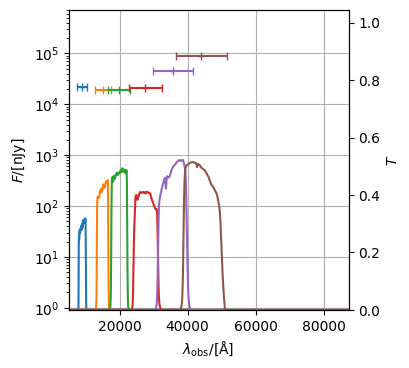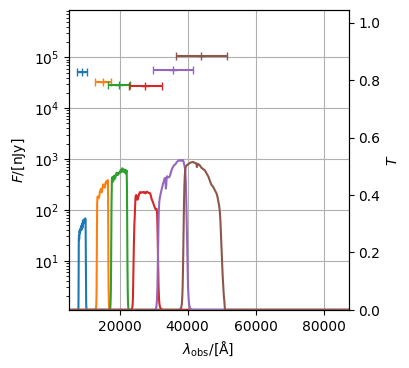Generating photometry from a Galaxy¶
If you are working with a Galaxy (or many Galaxy objects) containing multiple spectra, you can use the galaxy level get_photo_lnu and get_photo_fluxes methods to generate photometry for all spectra in the galaxy.
Before we can demonstrate this we firs need to make a parametric galaxy with a Stars and Blackhole component, define an emission model for a whole galaxy and generate their rest–frame and observed spectra.
[1]:
import numpy as np
from astropy.cosmology import Planck18 as cosmo
from unyt import Mpc, Msun, Myr, kelvin, yr
from synthesizer.emission_models import (
AttenuatedEmission,
BimodalPacmanEmission,
DustEmission,
EmissionModel,
UnifiedAGN,
)
from synthesizer.emission_models.attenuation import PowerLaw
from synthesizer.emission_models.dust.emission import Blackbody, Greybody
from synthesizer.filters import FilterCollection
from synthesizer.grid import Grid
from synthesizer.parametric import SFH, ZDist
from synthesizer.parametric import Stars as ParametricStars
from synthesizer.particle import BlackHoles, Galaxy
from synthesizer.particle.stars import sample_sfzh
# Get the grids which we'll need for extraction
grid_dir = "../../../tests/test_grid"
grid_name = "test_grid"
grid = Grid(grid_name, grid_dir=grid_dir)
nlr_grid = Grid("test_grid_agn-nlr", grid_dir="../../../tests/test_grid")
blr_grid = Grid("test_grid_agn-blr", grid_dir="../../../tests/test_grid")
# Define the metallicity history
zh = ZDist.DeltaConstant(metallicity=0.01)
# Define the star formation history
sfh_p = {"max_age": 100 * Myr}
sfh = SFH.Constant(**sfh_p)
# Initialise the parametric Stars object
param_stars = ParametricStars(
grid.log10age,
grid.metallicity,
sf_hist=sfh,
metal_dist=zh,
initial_mass=10**9 * Msun,
)
# Define the number of stellar particles we want
n = 500
# Sample the parametric SFZH, producing a particle Stars object
# we will also pass some keyword arguments for some example attributes
part_stars = sample_sfzh(
sfzh=param_stars.sfzh,
log10ages=param_stars.log10ages,
log10metallicities=param_stars.log10metallicities,
nstar=n,
current_masses=np.full(n, 10**8.7 / n) * Msun,
redshift=1,
coordinates=np.random.normal(0, 0.01, (n, 3)) * Mpc,
centre=np.zeros(3) * Mpc,
tau_v=np.random.rand(n),
)
# Make fake properties
n = 4
masses = 10 ** np.random.uniform(low=7, high=9, size=n) * Msun
coordinates = np.random.normal(0, 0.01, (n, 3)) * Mpc
accretion_rates = 10 ** np.random.uniform(low=-2, high=1, size=n) * Msun / yr
metallicities = np.full(n, 0.01)
# And get the black holes object
blackholes = BlackHoles(
masses=masses,
coordinates=coordinates,
accretion_rates=accretion_rates,
metallicities=metallicities,
)
# And create the galaxy
gal = Galaxy(
stars=part_stars,
black_holes=blackholes,
redshift=1,
)
# Get the stellar pacman model
pc_model = BimodalPacmanEmission(
grid=grid,
tau_v_ism=1.0,
tau_v_birth=0.7,
dust_curve_ism=PowerLaw(slope=-1.3),
dust_curve_birth=PowerLaw(slope=-0.7),
dust_emission_ism=Blackbody(temperature=100 * kelvin),
dust_emission_birth=Blackbody(temperature=30 * kelvin),
fesc=0.2,
fesc_ly_alpha=0.9,
label="stellar_total",
)
pc_model.save_spectra("stellar_total", "intrinsic")
# Get the UnifiedAGN model
uni_model = UnifiedAGN(
nlr_grid,
blr_grid,
covering_fraction_nlr=0.1,
covering_fraction_blr=0.1,
torus_emission_model=Blackbody(1000 * kelvin),
label="agn_intrinsic",
ionisation_parameter=0.1,
hydrogen_density=1e5,
)
# Define an emission model to attenuate the intrinsic AGN emission
att_uni_model = AttenuatedEmission(
dust_curve=PowerLaw(slope=-1.0),
apply_to=uni_model,
tau_v=0.7,
emitter="blackhole",
label="agn_attenuated",
)
gal_intrinsic = EmissionModel(
label="total_intrinsic",
combine=(uni_model, pc_model["intrinsic"]),
emitter="galaxy",
)
gal_attenuated = EmissionModel(
label="total_attenuated",
combine=(att_uni_model, pc_model["attenuated"]),
related_models=(gal_intrinsic,),
emitter="galaxy",
)
# And now include the dust emission
gal_dust = DustEmission(
dust_emission_model=Greybody(30 * kelvin, 1.2),
dust_lum_intrinsic=gal_intrinsic,
dust_lum_attenuated=gal_attenuated,
emitter="galaxy",
label="dust_emission",
)
gal_total = EmissionModel(
label="total",
combine=(gal_attenuated, gal_dust),
related_models=(gal_intrinsic),
emitter="galaxy",
)
# Get the spectra
sed = gal.get_spectra(gal_total)
# Get fluxes
gal.get_observed_spectra(cosmo)
/tmp/ipykernel_7454/2220007528.py:14: FutureWarning: The filters module has been moved to the instruments module. Please update your imports synthesizer.filters -> synthesizer.instruments
from synthesizer.filters import FilterCollection
/opt/hostedtoolcache/Python/3.10.16/x64/lib/python3.10/site-packages/unyt/array.py:1832: RuntimeWarning: divide by zero encountered in log10
out_arr = func(np.asarray(inp), out=out_func, **kwargs)
/opt/hostedtoolcache/Python/3.10.16/x64/lib/python3.10/site-packages/unyt/array.py:1832: RuntimeWarning: overflow encountered in exp
out_arr = func(np.asarray(inp), out=out_func, **kwargs)
/opt/hostedtoolcache/Python/3.10.16/x64/lib/python3.10/site-packages/unyt/array.py:1972: RuntimeWarning: overflow encountered in multiply
out_arr = func(
We can then combine with a FilterCollection to generate the galaxy-level photometry.
[2]:
# Get the filter collection
fs = [
f"JWST/NIRCam.{f}"
for f in ["F090W", "F150W", "F200W", "F277W", "F356W", "F444W"]
]
filters = FilterCollection(
filter_codes=fs,
new_lam=grid.lam,
)
# Get the photometry
gal.get_photo_lnu(filters)
gal.get_photo_fnu(filters)
The photometry produced by these methods are stored in the photo_lnu and photo_fluxes attributes, either at the base galaxy level or the individual components. These attributes are dictionaries containing the photometry for each spectra key.
For example, on the Galaxy.Stars object:
[3]:
print(gal.stars.photo_lnu)
print(gal.stars.photo_fnu)
{'intrinsic': <synthesizer.photometry.PhotometryCollection object at 0x7f5771b4f8b0>}
{'intrinsic': <synthesizer.photometry.PhotometryCollection object at 0x7f5771b4fe20>}
Or on the galaxy level
[4]:
print(gal.photo_lnu)
{'total': <synthesizer.photometry.PhotometryCollection object at 0x7f57bcb563b0>, 'total_attenuated': <synthesizer.photometry.PhotometryCollection object at 0x7f57bcb56230>, 'dust_emission': <synthesizer.photometry.PhotometryCollection object at 0x7f57bcb56020>, 'total_intrinsic': <synthesizer.photometry.PhotometryCollection object at 0x7f57bcb55de0>}
As before we can print the photometry.
[5]:
print(gal.photo_fnu["total_attenuated"])
-----------------------------------------------------
| PHOTOMETRY (FLUX) |
|------------------------------------|--------------|
| JWST/NIRCam.F090W (λ = 9.02e+03 Å) | 2.20e+04 nJy |
|------------------------------------|--------------|
| JWST/NIRCam.F150W (λ = 1.50e+04 Å) | 1.91e+04 nJy |
|------------------------------------|--------------|
| JWST/NIRCam.F200W (λ = 1.99e+04 Å) | 1.91e+04 nJy |
|------------------------------------|--------------|
| JWST/NIRCam.F277W (λ = 2.76e+04 Å) | 2.07e+04 nJy |
|------------------------------------|--------------|
| JWST/NIRCam.F356W (λ = 3.57e+04 Å) | 4.59e+04 nJy |
|------------------------------------|--------------|
| JWST/NIRCam.F444W (λ = 4.40e+04 Å) | 9.05e+04 nJy |
-----------------------------------------------------
Or plot them.
[6]:
gal.photo_fnu["total_attenuated"].plot_photometry(show=True)
[6]:
(<Figure size 350x500 with 2 Axes>,
<Axes: xlabel='$\\lambda_\\mathrm{obs}/[\\mathrm{\\AA}]$', ylabel='$F/[\\mathrm{\\rm{nJy}}]$'>)

[7]:
gal.photo_fnu["total_intrinsic"].plot_photometry(show=True)
[7]:
(<Figure size 350x500 with 2 Axes>,
<Axes: xlabel='$\\lambda_\\mathrm{obs}/[\\mathrm{\\AA}]$', ylabel='$F/[\\mathrm{\\rm{nJy}}]$'>)

[8]:
gal.photo_fnu["total"].plot_photometry(show=True)
[8]:
(<Figure size 350x500 with 2 Axes>,
<Axes: xlabel='$\\lambda_\\mathrm{obs}/[\\mathrm{\\AA}]$', ylabel='$F/[\\mathrm{\\rm{nJy}}]$'>)

Calculating light radii¶
Once we have photometry we can calculate the radius enclosing a given fraction of the light for a component. Here we’ll calculate the half light radius for both the intrinsic emission and the total emission in “F444W” in terms of luminosity, but before we can do that we need to get the particle spectra and call get_particle_photo_lnu to first calculate the per particle photometry (above we used the galaxy level methods to calculate integrated spectra).
[9]:
# Get the particle spectra
pc_model.set_per_particle(True)
gal.stars.get_spectra(pc_model)
# Get the particle photometry
gal.stars.get_particle_photo_lnu(filters)
int_r50 = gal.stars.get_half_luminosity_radius(
"intrinsic", "JWST/NIRCam.F444W"
)
tot_r50 = gal.stars.get_half_luminosity_radius(
"stellar_total", "JWST/NIRCam.F444W"
)
print(int_r50, tot_r50)
0.014835651418463169 Mpc 0.014835669967176586 Mpc
Similarly to the “attr” radii we can compute for any particle component, we can also compute the radius enclosing any fraction of the light for any particle component.
[10]:
int_r20 = gal.stars.get_luminosity_radius(
"intrinsic", "JWST/NIRCam.F444W", frac=0.2
)
tot_r20 = gal.stars.get_luminosity_radius(
"stellar_total", "JWST/NIRCam.F444W", frac=0.2
)
int_r80 = gal.stars.get_luminosity_radius(
"intrinsic", "JWST/NIRCam.F444W", frac=0.8
)
tot_r80 = gal.stars.get_luminosity_radius(
"stellar_total", "JWST/NIRCam.F444W", frac=0.8
)
print(int_r20, int_r80, tot_r20, tot_r80)
0.009099462431901958 Mpc 0.021448761756570463 Mpc 0.009099506025286802 Mpc 0.021428136352285777 Mpc
Calculating weighted attributes¶
Similarly to the weighted attributes shown in the stellar component docs, we can also calculate luminosity and flux weighted attributes for the galaxy’s components. Again these exist in generic and specific attribute forms. First we demonstrate the generic form, this requires the attribute to weight, the spectra type, and the filter code to weight by as arguments.
[11]:
print(
gal.stars.get_lum_weighted_attr(
"log10ages", "stellar_total", "JWST/NIRCam.F444W"
)
)
7.035158196612078 dimensionless
We can also do this for fluxes.
[12]:
# We haven't computed fluxes yet so lets do that first
gal.stars.get_spectra(pc_model)
gal.get_observed_spectra(cosmo)
gal.stars.get_particle_photo_fnu(filters)
print(
gal.stars.get_flux_weighted_attr(
"log10ages", "stellar_total", "JWST/NIRCam.F444W"
)
)
7.281515908577526 dimensionless
We also provide some specific methods for commonly weighted attributes. These methods still require the spectra type and filter code as arguments, but the attribute to weight is fixed.
[13]:
print(gal.stars.get_lum_weighted_age("stellar_total", "JWST/NIRCam.F444W"))
print(gal.stars.get_flux_weighted_age("stellar_total", "JWST/NIRCam.F444W"))
print(
gal.stars.get_lum_weighted_metallicity(
"stellar_total", "JWST/NIRCam.F444W"
)
)
print(
gal.stars.get_flux_weighted_metallicity(
"stellar_total", "JWST/NIRCam.F444W"
)
)
print(
gal.stars.get_lum_weighted_optical_depth(
"stellar_total", "JWST/NIRCam.F444W"
)
)
print(
gal.stars.get_flux_weighted_optical_depth(
"stellar_total", "JWST/NIRCam.F444W"
)
)
24461036.419216245 yr
32466174.773858037 yr
0.01
0.01
0.517605731523964
0.5038768313987247